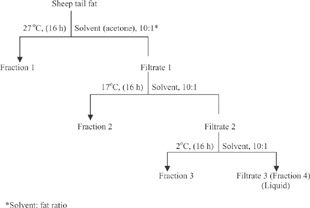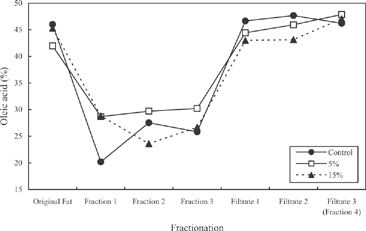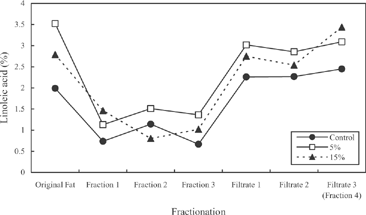Abstract
This experiment was carried out to evaluate the effects of diets containing different levels (0%, 5%, and 15 %) of ground Rosa canina L seed, the residue remaining after the extraction of rose hip syrup, which is currently manufactured in Turkey as an energy source in diets. These include different proportion of barley and wheat bran on some characteristics of fractions separated by an acetone crystallization of edible tail fats obtained from tail tissues of Morkaraman male lambs at approximately 10 months of age (8 months plus 60 days dietary treatment). Four fractions and two filtrates were obtained from all of the sheep tail fat. The melting point, refractive index, iodine value, and fatty acid composition were determined for each of the fractions and filtrates. As the fractionation temperature decreased, the concentration of unsaturated fatty acids in the fractions increased. In addition, the effects of fractionation (p<0.01) and treatment (p<0.01) on melting point, refractive index, and fractionation (p<0.01) on iodine value were statistically significant. Lauric, myristic, palmitic, palmitoleic, margaric, and linoleic acids were affected by the fractionation (p<0.01) and treatment factors (p<0.01). Fractionation also had a significant effect on stearic (p<0.01) and oleic acids (p<0.01). Fractionation x treatment interaction also had a significant effect on myristic, palmitic, palmitoleic, margaric, stearic, oleic, and linoleic acids.
INTRODUCTION
Animal fats are an important source of fat in Turkey. Sheep tail fat accounts for a large proportion of Turkish animal fat production. Turkey has 30,238,000 sheep, and 87% of these sheep are fatty tail.[Citation1,Citation2] In 1997, it was reported that 6,500,000 sheep are slaughtered annually.[Citation1] Since the average weight of sheep tail in Turkey is approximately 4 kg, an estimated 22,600 tons of tail tissue is used effectively in the food or confectionery industry. However, there are not enough studies conducted on the benefits of sheep tail fat. Cocoa butter, palm oil, palm kernel oil and coconut oil, are used in the food and confectionery industries.[Citation3] Products from fractionated tallow have been used as substitutes for and extenders of cocoa butter, palm oil, and other fats and oils in the food and confectionery industries. Therefore, thinking that will be using in sheep tail fat in the food and confectionery industries. In recent years, three methods have been used in the fractionation of fats in industry. Fractionation is the removal of solids by controlled crystallization and separation techniques involving the use of solvents. It includes dry fractionation, solvent fractionation, and aqueous fractionation. The solvent fractionation is preferable in the food and confectionery industries because the filtration is higher and a much more efficient fraction separation can be achieved. In solvent fractionation, edible sheep tail fat has been effectively fractionated by an acetone crystallization procedure and can be divided into three portions. The first is a solid portion that can be used to harden shortenings and margarines without hydrogenation. The second is a semi-solid portion, comparable to cocoa butter, that can be used to replace cocoa butter in chocolate candy bars. The third portion is a liquid that shows promise as a general purpose oil. [Citation3–5] Solvent fractionation is practiced commercially to produce hard butters, specialty oils, and some salad oils from a wide array of edible oils.[Citation7] To change the characteristics of edible fats and oils, fractionation, hydrogenation, and interesterification methods are used together. It is possible to get the different fractions at different melting points, hardness, and solid fat content levels by means of several fractionations of fats and oils.[Citation5–7] It has been reported that changes in physical characteristics of fats and oils have been made by adjusting fractionation conditions.[Citation5,Citation7,Citation8] The purpose of this study was to determine the effects of isonitrogenic and isocaloric diets that contained three different levels (0%, 5%, and 15%) of ground Rosa canina L. on some edible tail fat fractionations, fractionated by acetone crystallization, and also to determine the optimization of olein yields and the characterization of the resulting fractions.
MATERIALS AND METHODS
The experiment was conducted at the Application and Research Farm of the College of Agriculture, Ataturk University, Erzurum, Turkey. A total of 36 fat tailed Morkaraman male lambs were used in the study as animal material. The lambs were allowed to adapt to the concentrate in order to reduce the incidence of rumen acidosis for 2 weeks. After the adaptation period, the lambs at 8 months of age were divided into three treatment groups: a control group fed with a basal diet (T1, n=12) and two experimentals (T2, n=12 and T3, n=12) at the beginning of the fattening period. Formulation and chemical composition of different treatment diets on dry matter basis are shown in . The experimental diets were approximately formulated to meet the nutrient requirements of the lambs according to an isonitrogenous and isocaloric basis. The T2 and T3 lambs were fed with a concentrate that included 5% and 15% of ground Rosa canina L. seed. Rosa canina L. seed consisted of 90-93.4% dry matter, 2-3.41% ash, 44.05% crude fibre, 8.22-9.15% crude protein, and 7.02-8.92% ether extract. The ether extract of Rosa canina L. seed contained 5.3% palmitic acid, 24.6% stearic acid, 50.7% oleic acid, and 19.3% linoleic acid. All groups were fed with a diet consisting of concentrate mixture, offered ad libitum, and 300 g of grass hay per lamb per day during a 60-day fattening period. The fatty acid composition of grass hay was not determined because lambs in T1, T2, and T3 groups were fed with the same amount of grass hay. The ether extract of the T1 diet consisted of 27.06% palmitic, 5.40% stearic, 46.27% oleic, and 10.23% linoleic acid. The grass hay had 91.68% dry matter, 6.05% crude protein, 27.55% crude fibre, 2.65% ether extract, 9.30% ash, and 46.13% nitrogen-free extract. Dry matter, crude protein, ether extract, and ash of concentrates and grass hay were determined by standard methods.[Citation9] Neutral and acid detergent fibers (NDF, ADF) were determined according to the method of Goering and Van Soest.[Citation10]
Table 1 Formulation and chemical composition of different treatment diets fed to Morkaraman lambs for 60 days
At the end of fattening period, lambs were slaughtered and the carcasses were chilled at 4oC for 24 h. Then the tail tissues were removed from each carcass and used as experimental materials. Sheep tail tissues of each group were ground once through a 3-mm plate. The tail fat were prepared by melting adipose tissue at 60oC in a water bath and straining it through a double-fold muslin cloth. The tail fat was used without further purification. Proximate analysis showed that water, fat, and nitrogen contents of sheep tail tissues were 16.12%, 80.18%, and 3.43%, respectively, for T1; 16.24%, 80.03%, and 3.16% respectively, for T2; and 16.18%, 80.38%, and 3.07%, respectively, for T3 group. The water content of the T1, T2, and T3 groups of sheep tail fat were 0.06%, 0.05% and 0.05%, respectively.
Fractionation of Sheep Tail Fats
The solvent fractionation of each treatment group of sheep tail fats was performed as described by Ohtake.[Citation11] The acetone used in the study was anhydrous, a reagent grade of low residue (0.0005%) distilled in glass. The outline of the crystallization scheme, solvent-sample ratios, and the crystallization temperatures are given in . Constant temperatures were used to obtain the crystallization temperatures of 27, 17, and 2oC. In each crystallization, the acetone solutions were held overnight (minimum of 16h) at the stated temperature with only occasional stirring during the initial cooling. The solutions were filtered at the crystallization temperatures with filter paper. The filter cake was washed with additional acetone. The fractions were freed of solvent by distillation on a steam bath temperature under an N2 atmosphere, followed by vacuum treatment on a rotary evaporator, also under an N2 atmosphere. The isolated fractions were stored at 2oC under conditions designed to minimize oxidation.
Physical and Chemical Analysis
Yield values were determined on weight basis after each process was applied to 100 g of original tail fats.[Citation5] The melting points of the original sheep tail fats and their fractions were determined by using capillary tubes. Samples were sealed in capillary tubes and frozen. Frozen samples were attached near the bulb-end of a mercury thermometer and subsequently submerged into a warming water bath. In the capillary tube, the beginning point of the movement was determined by endpoint.[Citation12] The refractive index of the original sheep tail fats and its fractions were determined by Abbe refractometry at 50oC.[Citation13] All fractions, along with the original sheep tail fat, were subjected to the Wijs method of determining iodine values.[Citation13]
Fatty Acid Analysis
Original sheep tail fats and fractionated samples were methylated by the boron trifluoride-methanol method of Morrison and Smith.[Citation14] Fatty acid methyl esters were analyzed by gas chromatograph (PerkinElmer Instrument Auto System XL gas chromatograph) with a capillary column (SGE, 60m x 0.25mm ID-BP x 70, 0,25) under the following conditions: temperature increasing from 150 to 250oC at a rate of 2oC/min.; flame ionization detector (H2 and dry air) at 240oC; helium gas (1mL/min, 150kPa); and injection block temperature of 250oC.
Statistical Analysis
Data were subjected to an analysis of variance fixed with the main effects with dietary treatment, fractionation, and the interaction of dietary treatments by fractionation. Significant differences (p<0.05) between means were tested using Duncan's Multiple Range Test.[Citation15]
RESULTS AND DISCUSSION
Means of yield, melting point, refractive index, iodine value, and fatty acid composition of fraction and filtrates obtained from each solvent fractionation of sheep tail fats are presented in . Means of melting point, refractive index, iodine value, and fatty acid composition of sheep tail fats from control (T1) and treatment groups (T2 and T3) are presented in .
Table 2 Means of yield, melting point, refractive index, iodine value, and fatty acid composition of fraction and filtrates obtained from each solvent fractionation of sheep tail fats, averaged across all dietary treatments
Table 3 Means of melting point, refractive index, iodine value, and fatty acid composition of sheep tail fats from control (T1) and treatment groups (T2 and T3)
Fractionation caused large variations (p<0.01) in melting point values of fats. While melting point of the original tail fats from all 3 groups was 34.30oC, the melting point was 19.57oC for filtrate 2, and fraction 4 was obtained as liquid fat (). The on melting points was significant (p<0.01) in the treatment groups. The melting point of the T1 group was higher than T2 and T3 (). In addition, results related to the refractive index and iodine value changed in accordance with the resulting melting point. These changes are recorded in . Results indicated that the characteristics of sheep tail fats may be changed by solvent fractionation. The effects of fractionation (p<0.01; ) and treatment factors (p<0.01; ) on refractive index were statistically significant. Fractionation also influenced (p<0.01) the iodine value (). These results on melting point, refractive index, and iodine value were similar to fractionation studies of beef tallow, sheep bone marrow fat, and sheep tail fat.[Citation3,Citation5,Citation11,Citation16–18] To the best of our knowledge, studies published on the quality parameters of sheep tail fat are insufficient. Some researchers reported a range of 31-46 oC for melting points, 43-60 for iodine values, and 1.4542-1.4625 for the refractive index of sheep tail fat.[Citation5,Citation19–27] Our results may differ from the results of other researchers due to the differences among sheep; the sheep's diet, sex, age, breed, and the diet of the lambs before experimental diets were imposed.
The effects of fractionation (p<0.01) on lauric acid were statistically significant. The averages of fraction 1, fraction 2, and fraction 3 were lower than averages of original fat tails () Also, lauric acid content significantly (p<0.01) changed with treatment, and the maximum value was determined in T2 group (). Fractionation (p<0.01) (), treatment factors (p<0.01) (), and fractionation x treatment interaction (p<0.01) had a significant effect on myristic (), palmitic (), palmitoleic (), and margaric acid (). The average of myristic acid of fraction 2 and fraction 3 was higher (p<0.05) than those of original tail fat, fraction 1, filtrate 1, filtrate 2, and fraction 4 (). The myristic acid content of the T2 group was lower (p<0.05) than those of T1 and T3 groups (). The percentage of palmitic acid in fraction 1, fraction 2, and fraction 3 obtained by solvent fractionation was higher (p<0.05) than that of original fats. The fractions 1, 2, and 3 were probably more solid because they included more palmitic acid and other saturated fatty acids. The proportion of palmitoleic acid in the hard fractions (fraction 1, 2, and 3) was lower than that of soft fractions (filtrate 1, filtrate 2, and fraction 4) (). The palmitoleic acid content of the original tail fat from T1 was lower (p<0.05) than that of the original tail fat obtained from the T3 group fed the 15% ground Rosa canina L. seed diet (). In addition, the palmitoleic acid contents of filtrate 1, filtrate 2, and fraction 4 of T2 group were lower than T1 and T3 groups (). The margaric acid proportions of fraction 1, 2, and 3 were higher (p<0.05) than those of original tail fats. The proportion of margaric acid was low in filtrates and fraction 4 (), demonstrating that hard and soft fractions include more saturated and unsaturated fatty acids, respectively. In the T2 group, the highest content of margaric acid was observed in all fractions and filtrates (). The margaric acid content of original tail fat from T2 was higher (p<0.01) than those of the original tail fat obtained from the T1 and T3 groups fed on diets with and without 15% ground Rosa canina L. seed (). While the effect of fractionation (p<0.01) on stearic and oleic acid was significant (), the effect of treatment was not found (). The effect of fractionation x treatment interaction on stearic acid (p<0.01; ) and oleic acid (p<0.05) ) was also significant. The stearic acid contents of fraction 1, 2, and 3 were higher (p<0.05) than those of the original tail fats, and the maximum stearic acid amount was observed in hard fractions such as other saturated fatty acids (). The proportion of oleic acid in hard fractions was lower than that of soft fractions (). These results indicated that olein yields of filtrate 1, filtrate 2, and fraction 4 were higher. Thus, these important products can be used in the food industry or as replacements for more expensive fats and oils in the food and confectionary industries. The fractionation (p<0.01; ), treatment factors (p<0.01; ), and fractionation x treatment interaction (p<0.01; ) had a significant effect on linoleic acid. It was determined that proportion of linoleic acid in hard fractions was lower than that of soft fractions (). The lowest amount of linoleic acid in all fractions and in original tail fats was obtained at T1 compared to T2 and T3 (). Therefore, linoleic acid contents of T2 and T3 groups were higher (p<0.05) than those of T1 group (). The fatty acid composition of sheep tail fat has been studied by Kayahan,[Citation22] Ahi,[Citation26] and Ünsal.[Citation28] In these publications, average percentages of the sheep tail fat have been determined as C14:0 between 4.21 and 5.2%; C16:0 between 21.8 and 28.0%; C16:1 between 2.7 and 4.6%; C18:0 between 7.9 and 20.41%; C18:1 between 41.51 and 49.7%; C18:2 between 2.62 and 5.7%; and C20:0 between 0.26 and 1.8%. Results from our present study were in agreement with findings of other fractionation studies of animal fats [Citation3,Citation5,Citation11,Citation16–18]. There are differences in the fatty acid compositions of the sheep tail fat. These differences on fatty acid composition may be attributed to breed, age, sex, and animal dietary composition. Furthermore, significant interactions among dietary treatments and fractionation methods may also explain differences among the various studies.
Figure 2 The effect of fractionation x treatment interaction on myristic acid from tail fat of Morkaraman 10 month old lamb fed 0%, 5%, or 15% Rosa canina L. seeds.
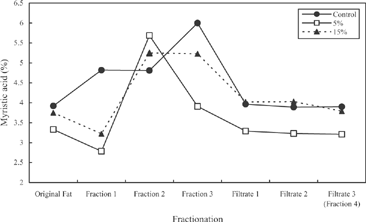
Figure 3 The effect of fractionation x treatment interaction on palmitic acid from tail fat of Morkaraman 10-month old lamb fed 0%, 5%, or 15% Rosa canina L. seeds.
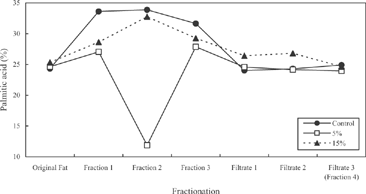
Figure 4 The effect of fractionation x treatment interaction on palmitoleic acid from tail fat of Morkaraman 10-month old lamb fed 0%, 5%, or 15% Rosa canina L. seeds.
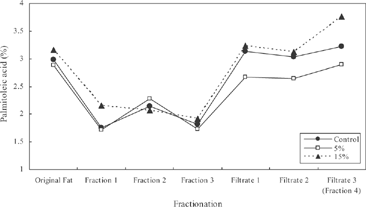
Figure 5 The effect of fractionation x treatment interaction on margaric acid from tail fat of Morkaraman 10-month old lamb fed 0%, 5%, or 15% Rosa canina L. seeds.
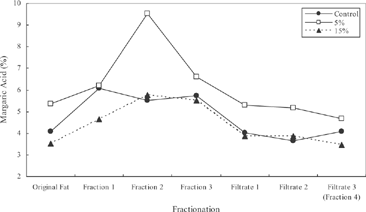
Figure 6 The effect of fractionation x treatment interaction on stearic acid from tail fat of Morkaraman 10‐month old lamb fed 0%, 5%, or 15% Rosa canina L. seeds.

CONCLUSION
Findings obtained from the present study showed that the composition of sheep tail fats may be changed using a solvent fractionation method that varies the proportion of Rosa canina L. seeds (from 0-15%) and among fractions of sheep feed and diets. In addition, it was observed that fatty acid composition of fractions and filtrates of sheep tail fats changed with changes in the fractionation temperature. The fatty acids, except for stearic and oleic, were significantly affected by diets with Rosa canina L. seeds (especially from level 5%). Perhaps the liquid fraction obtained by solvent fractionation from sheep tail fats can be utilized as salad oil in human nutrition. Solid fractions can also be used to harden margarine without hydrogenation. The fractionation method can be used in sheep tail fat in the food industry according to results of this study.
ACKNOWLEDGMENT
This work was supported by the Fund for Scientific Research, Ataturk University.
Notes
Goering, H.K.; Van Soest, P.J. Forage Fibre Analysis. US Department of Agriculture, 1970, Handbook no. 379, p. 20. USDA Washington, DC, USA.
REFERENCES
- Anonymous . 1997 . Structure of Agricultural (Production, Cost, Value) , Ankara, , Turkey : T.C. Başbakanlik Devlet Istatistik Enstitüsü .
- Düzgüneş , O. 1986 . Animal breeding studies in Turkey. First West Mediterranean Livestock Seminar 12 – 21 . Antalya, , Turkey
- Bussey , D.M. , Ryan , T.C. , Gray , J.I. and Zabik , M.E. 1981 . Fractionation and characterization of edible tallow . J. Food Sci. , 46 : 526 – 530 .
- Gümüşkesen , A.S. , Yemişcioğlu , F. and Bayaz , M. September 1997 . “ Fractional crystallization: techniques and applications to palm oil ” . In Third National Food Engineering Symposium , Edited by: Öztan , A. and Vural , H. September , Ankara, , Turkey : Hacettepe University, Engineering Faculty .
- Ünsal , M. and Aktaş , N. 2003 . Fractionation and characterization of edible sheep tail fat . Meat Sci. , 63 : 235 – 239 . [CROSSREF]
- Abeshima , T. 1998 . Fractionation of edible oils and fats . J. Japan Oil Chem. Soc. , 47 : 553 – 561 .
- Kayahan , M. 2002 . Modified Fats and Techniques of Production. (Turkish) , Ankara, , Turkey : Middle East Technical University .
- Allen , D.A. 1998 . Fat modification as a tool for product development . I. Hydrogenation and fractionation. Lipid Tech. , 10 : 29 – 33 .
- AOAC . 1990 . Official Methods of Analysis of the Association of Official Analytical Chemists , 15th , 684 Arlington, VA, USA : Association Analytical Chemists .
- Goering, H.K.; Van Soest, P.J. Forage Fibre Analysis. US Department of Agriculture, 1970, Handbook no. 379, p. 20. USDA Washington, DC, USA.
- Ohtake , Y. 1983 . Fatty acid distributions in sheep bone marrow lipids . J. Jap. Soc. Nutr. Food Sci. , 36 : 37 – 42 .
- Nas , S. , Gökalp , H.Y. and Ünsal , M. 2001 . Technology of Vegetable Oil (Turkish) , Denizli, , Turkey : Pamukkale University Engineering Faculty .
- AOCS . 1977 . Official and TentativeMethods , 3rd , Champaign, IL : AOCS Pres. .
- Morrison , W.R. and Smith , L.M. 1964 . Preparation of fatty acid methyl esters and dimethylacetals from lipids with boron fluoridemethanol . J.Lipid Res. , 5 : 600
- Duncan , D.B. 1955 . Multiple range multiple F tests . Biometrics , 11 : 1 – 42 .
- Luddy , F.E. , Hampson , J.W. , Herb , S.F. and Rothbart , H.L. 1973 . Development of edible tallow fractions for specialty fat uses . J. Am. Oil Chem. Soc. , 50 : 240 – 244 .
- Taylor , H.H. , Luddy , F.E. , Hampson , J.W. and Rothbart , H.L. 1976 . Substitutability of fractionated beef tallow for other fats and oils in the food and confectionery industries: an economic evaluation . J. Am. Oil Chem. Soc. , 53 : 491 – 495 .
- Grompone , M.A. 1989 . Physicochemical properties of fractionated beef tallows . J. Am. Oil Chem. Soc. , 66 : 253 – 255 .
- Parvaneh , V. 1972 . The physical and chemical characteristics of sheep tail fat (Donbeh) . Tropical Sci. , 14 : 169 (FST Abstract)
- şengonca , M. and Sarican , C.A. 1974 . Research Work on the Fattening Ability, Carcass Quality and Relationship of These Characteristics with the Serum Alcali Phosphatese, (AP) Activities , (No.229) Izmir, , Turkey : Ege University, Agricultural College .
- Biyikoğlu , K. 1977 . The Effects of Docking of Morkaramans on Growth, Meat Yield and Quality in Eastern Anatolia , Erzurum, , Turkey : Atatürk University .
- Kayahan , M. 1981 . Research on the margarine operation of animal fats by using methods of interchange of fatty acid radical in triglyceride molecules , Turkey : Ege University, The Faculty of Food Bornova .
- Kamel , B.S. 1983 . Characteristics, composition and oxidative stability of sheep tail tallow . Canadian Inst. of Food Sci. And Tech. Journal. , 16 : 76 (FST Abstract)
- Nour-El-Din , H. , Soliman , A. , Ashour , F. and Bayoumi , A. 1984 . Chemical composition of porf and mutton in Egypt . Proceeding of the European Meating of Meat Research Workers , 30 ( 3 ) : 29 – 149 . Food Tech. Dep., Fac. of Agric. Moshtohor, Zagazig Univ., Zagazig, Egypt. (FST Abstract)
- Karakaya , M. Some emulsion characteristics of different species meat with the animal fats and vegetable oils, studies in model system . 1990 . Ph.D thesis, Atatürk University Food Science and Technology Department, Erzurum, Turkey
- Ahi , F.A. Research on high oxidation stability oil production by using methods of interchange of fatty acid radical in triglyceride molecules (interesterification) . 1993 . Master thesis, Ankara University, Graduate School of Natural and Applied Science, Department of Food Science, Ankara, Turkey
- Ünsal , M. , Gökalp , H.Y. and Nas , S. 1995 . Basic chemical characteristics of fresh, non-packed and vacuum-packed sheep-tail and tail-fat stored frozen for different periods . Meat Sci. , 39 : 195 – 204 . [CROSSREF]
- Ünsal , M. Some properties of fresh tail fat treated with different technological process and determination of some changes in some properties during storage under various conditions . 1996 . Ph.D. thesis, Atatürk University Graduate Institute of Science, Erzurum, Turkey
